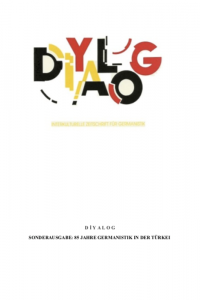Öz
Türkçe, Almanca, İngilizce gibi doğal dillerde bir tümce temelde özne ve yüklemden oluşur. Benzer şekilde biçimsel dillerde de bir tümce, yüklem ve argümandan oluşur. Yüklemler P, Q, R gibi büyük harflerle, argümanlar ise x, y, z gibi küçük harflerle gösterilir. Örneğin olumlu bir tümce P(x), olumsuz bir tümce ise –P(x) şeklinde ifade edilebilir. Ancak bazen bir tümcenin olumlu mu yoksa olumsuz mu olduğu net bir şekilde belli olmayabilir. Bu tür durumlarda mevcut sembolik gösterimde belirsizlikler ortaya çıkabilmektedir. Olumlu tümcelere matematiksel olarak 1, olumsuz tümcelere ise 0 değerinin verildiği varsayılırsa, olumluluk veya olumsuzluk durumu belirsiz olan tümceler ancak bu iki değer arasında bir değer alabilir. Diğer bir deyişle P(x) şeklinde gösterilebilen bir tümceyi P1(x), -P(x) şeklinde gösterilen bir tümceyi ise P0(x) şeklinde ifade etmek mümkündür; fakat olumluluğu kesin olmayan tümceler bu değerlerle gösterilemeyeceği için başka bir ifade şekline ihtiyaç vardır. Çünkü bu tümcelerdeki iş, oluş veya hareketin gerçekleşme oranı ne 0 ne de 1’dir; 0 ve 1 arasında bir değerdir. Bu çalışmada bu tür tümcelerin biçimsel dillerde nasıl ifade edilebileceğine dair bir öneride bulunmak ve bulanık küme kuramıyla olumluluğu derecelendirmek amaçlanmıştır. Bu amaç doğrultusunda önerilen yaklaşım birtakım örnek tümceler üzerinde uygulanmış ve söz konusu tümceler bulanık sembolik bir gösterimle ifade edilmiştir.
Anahtar Kelimeler
biçimsel diller olumluluk, belirsizlik bulanık küme kuramı matematiksel dilbilim
Kaynakça
- Börekçi, Muhsine (2003): Türkçe Öğretimi Bakımından Dil Bilgisi Terimi ve Kavram Olarak Olumluluk-Olumsuzluk. TDAY-Belleten. 45,61.
- Elmas, Çetin (2016): Yapay Zeka Uygulamaları. Yapay Sinir Ağı/ Bulanık Mantık/ Sinirsel Bulanık Mantık/ Genel Algoritma. Ankara: Seçkin Yayıncılık (Güncellenmiş 3. Baskı).
- Hedstück, Ulrich (2012): Einführung in die Theoretische Informatik: Formale Sprachen und Automatentheorie. München: Oldenbourg Wissenschaftsverlag GmbH.
- Hengirmen, Mehmet (2007): Türkçe Dilbilgisi. Ankara: Engin Yayınevi (9. Baskı).
- Hodges, Wilfrid (1988): Logic – An Introduction to Elementary Logic. London: Penguin Books.
- İmrağ, Özge Sinem (2018): Üretici-Dönüşümsel Dil Bilgisi Işığında Almanca, Türkçe ve İngilizcede Olumsuz Önermelerin Dilbilimsel ve Mantıksal Açıdan İncelenmesi, Yayınlanmamış Doktora Tezi, Atatürk Üniversitesi Sosyal Bilimler Enstitüsü, Erzurum.
- Karahan, Leyla (2015): Türkçede Söz Dizimi, Ankara: Akçağ Yayınları (2. Baskı).
- Negnevitsky, Michael (2005): Artifical İntelligence: A Guide to Intelligent Systems. London: Addison Wesley (Second Edition).
- Terricabras, Josep Maria (2015): Language, Fuzzy Logic, Metalogic. Towards the Future of Fuzzy Logic. 21-29.
- Toksöz, Derya/Yılmaz Işık (2019): İnce Taneli Zeminler için Önerilen Bulanık Sınıflama Sürecinin Bir Uygulaması. Pamukkale Üniversitesi Mühendislik Bilimleri Dergisi. 535-544.
- Zadeh, Lotfi Aliasker (1965): Fuzzy sets. Information and Control 8(3). 338-353.
Öz
In natural languages such as Turkish, German and English, a sentence consists essentially of a subject and predicate. Similarly, in formal languages, a sentence consists of a predicate and an argument. The predicates are shown in capital letters such as P, Q, R, and arguments in small letters such as x, y, z. For example, an affirmative sentence can be expressed as P(x) and a negative sentence as –P(x). However, sometimes it is not clear whether a sentence is affirmative or negative. In such cases, uncertainties may arise in the present symbolic representation. Assuming that affirmative sentences are given a mathematical value of 1 and negative sentences are given a value of 0, sentences with an uncertain status of affirmative or negative can only take a value between these two values. In other words, it is possible to express a sentence that can be represented as P(x) as P1(x), and a sentence that is shown as -P(x) as P0(x). However, since the sentences whose affirmativeness is not certain cannot be represented by these values, another form of expression is needed. Because the realisation ratio of action, state or occurrence in these sentences is neither 0 nor 1, it is a value between 0 and 1. In this study, it is aimed to make a suggestion about how such sentences can be expressed in formal languages and to evaluate affirmativeness with fuzzy set theory. For this purpose, the proposed approach was applied on a number of example sentences and these sentences were expressed in a fuzzy symbolic representation.
Anahtar Kelimeler
Formal languages affirmativeness vagueness fuzzy set theory mathematical linguistics
Kaynakça
- Börekçi, Muhsine (2003): Türkçe Öğretimi Bakımından Dil Bilgisi Terimi ve Kavram Olarak Olumluluk-Olumsuzluk. TDAY-Belleten. 45,61.
- Elmas, Çetin (2016): Yapay Zeka Uygulamaları. Yapay Sinir Ağı/ Bulanık Mantık/ Sinirsel Bulanık Mantık/ Genel Algoritma. Ankara: Seçkin Yayıncılık (Güncellenmiş 3. Baskı).
- Hedstück, Ulrich (2012): Einführung in die Theoretische Informatik: Formale Sprachen und Automatentheorie. München: Oldenbourg Wissenschaftsverlag GmbH.
- Hengirmen, Mehmet (2007): Türkçe Dilbilgisi. Ankara: Engin Yayınevi (9. Baskı).
- Hodges, Wilfrid (1988): Logic – An Introduction to Elementary Logic. London: Penguin Books.
- İmrağ, Özge Sinem (2018): Üretici-Dönüşümsel Dil Bilgisi Işığında Almanca, Türkçe ve İngilizcede Olumsuz Önermelerin Dilbilimsel ve Mantıksal Açıdan İncelenmesi, Yayınlanmamış Doktora Tezi, Atatürk Üniversitesi Sosyal Bilimler Enstitüsü, Erzurum.
- Karahan, Leyla (2015): Türkçede Söz Dizimi, Ankara: Akçağ Yayınları (2. Baskı).
- Negnevitsky, Michael (2005): Artifical İntelligence: A Guide to Intelligent Systems. London: Addison Wesley (Second Edition).
- Terricabras, Josep Maria (2015): Language, Fuzzy Logic, Metalogic. Towards the Future of Fuzzy Logic. 21-29.
- Toksöz, Derya/Yılmaz Işık (2019): İnce Taneli Zeminler için Önerilen Bulanık Sınıflama Sürecinin Bir Uygulaması. Pamukkale Üniversitesi Mühendislik Bilimleri Dergisi. 535-544.
- Zadeh, Lotfi Aliasker (1965): Fuzzy sets. Information and Control 8(3). 338-353.
Ayrıntılar
| Birincil Dil | Türkçe |
|---|---|
| Bölüm | Makaleler |
| Yazarlar | |
| Yayımlanma Tarihi | 30 Eylül 2020 |
| Gönderilme Tarihi | 26 Mayıs 2020 |
| Yayımlandığı Sayı | Yıl 2020 85 Jahre Germanistik in der Türkei |
Cited By
Yeni medyada Türk-Alman ilişkileri bağlamında Türkçe ve Almanca söylem türlerinin karşılaştırmalı analizi
RumeliDE Dil ve Edebiyat Araştırmaları Dergisi
https://doi.org/10.29000/rumelide.1378970
www.gerder.org.tr/diyalog


